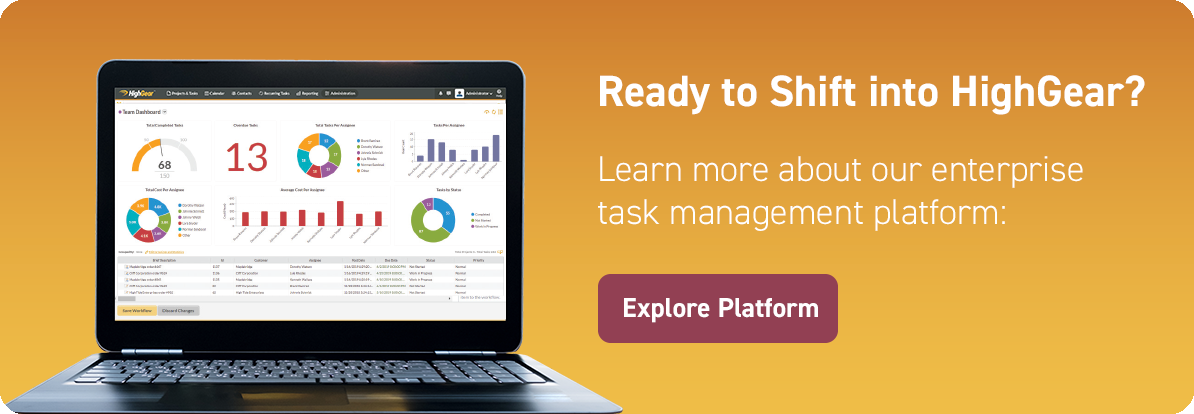In the financial industry, change is constant. New regulations, changing market conditions, and shifting consumer preferences are something financial services companies have come to expect. However, in the process of adapting to these constant changes, many companies break existing systems, circumvent well-established workflows with workarounds, and add more challenges.
The thorn in a financial services company’s side when trying to adapt to rapid change is having siloed workflows. These are workflows that exist purely in closed systems for a single line of business. Silos make it hard or impossible to enable information sharing across functional areas. When a new demand arises that regularly requires one department to get information from another, things can break down.
Siloed systems are sensitive — especially with financial information on the line. In some software solutions, merely changing the name of a field can break an entire workflow. Even altering permissions to make simple changes can break a business process. For example, if finance gets a new requirement to gather information from the HR system, the simple permission change required to address it can leave the entire HR system vulnerable for interruption.
The wrong way to deal with constant change
How have financial services companies traditionally dealt with this constant, expected change?
As the old adage goes, if you have big problems, you’re going to need big solutions. While this makes sense at the surface, it’s tempting to try to solve numerous tactical problems with a strategic solution. Strategic solutions require getting all of the stakeholders to work together for a comprehensive plan. Look out! This is when over-engineering will often come into play.
At HighGear, we consider over-engineering to be an enemy that we’re constantly helping our clients battle. Over-engineering usually comes in one of two forms:
- Trying to use a single big box solution for everything, even workflows it’s clearly not designed for. This may solve the issues of siloed systems but does so with a ‘one size rarely fits all’ solution for workflows of many different shapes and sizes, and the new gaps may lead to the same problem.
- Stringing together too many point or single-purpose solutions resulting in a myriad of solutions with a myriad of problems — often leaving behind a hodgepodge of overlapping functionality and integration complexity. This does not solve the problem of siloed systems.
Trying to shove everything into one box can be expensive and constraining. Cobbling together too many smaller solutions cause long lasting and expensive headaches. Even if the individual solutions are inexpensive, other costs like the extra work, additional time, endless maintenance, and never-ending troubleshooting add up over the long-term.
Plus, over-engineering tends to be the slow way to do things (often very slow) and can also put a financial services company at a competitive disadvantage when subsequent changes are required. Over-engineering is the opposite of ‘agility’.
What is agility and how do financial services companies achieve it?
Agility, in the business sense, can be defined as a company’s ability to make quick modifications, adapt processes, and modify existing systems and plans in reaction to new information. For financial services companies, agility means that they can adapt to the constantly changing regulatory and business environment.
To achieve agility, financial services companies must create adaptive workflow platforms. That means they need to be able to easily change processes on the fly, communicate between multiple departments on key business functions, and route work to the right person (regardless of what app they use to do the work).
Another way of thinking about agility is through the project management term ‘progressive elaboration’. Progressive elaboration refers to ‘ongoing improvement of a project plan based on new learnings and insights obtained during the project lifecycle’. Agility is essentially the same thing in the process world in that it enables you to quickly improve your operations when presented with new information or circumstances.
To lay the groundwork for agility, financial services companies must have the right systems in place.
Bundled workflow management vs workflow automation
To help their customers achieve agility, many solutions providers will ‘bundle’ workflow management capabilities on top of their existing platforms (often keeping workflows within the same siloed systems). While these solutions work great for what they’re intended to do, workflow management’s shelf-life and value proposition are reduced when forced into a silo.
More often than not, trying to adapt these bundled systems to Manage Workflows is like trying to force a square peg into a round hole. It might actually work, but IT or the development team is going to need to get involved to do some heavy patching. Because of that dependence on IT or development, the average business user is going to lose some control over their workflow and their ability to change when new requirements arise (not agile). IT will also inherit the burden of maintaining the patches, and in the modern reality, that’s becoming less practical every day.
On the other hand, workflow automation offers a cleaner path to agility. In a no-code workflow automation solution like HighGear, the business users are in the driver’s seat, rather than IT or software developers. They can use easy visual workflow design tools to craft custom processes that work across multiple teams, while IT can control which departments work, workflows, and people those business users can manage. Plus, the business users can update workflows at any time when new needs arise, giving them true agility without requiring IT involvement or coding.
Large class-specific solution vendors (think of the major options in the ERP space, for instance) know that their brand recognition makes bundling appealing to high-level decision makers. If you trust them for the biggest technology choice you will need to make in the next five years, why not trust them to make it even bigger to cover another need you have as well? But the problem with this strategy is that you may end up with is something the size of a Terex® earth mover, when your team needs the equivalent of a small sports car to zoom through the new market requirements or regulations they face.
Where agility can boost processes within the financial services industry
No-code workflow automation gives financial services companies heightened agility in whatever capability they need it for. Workflow software provides this agility in three primary areas: An overarching system of assignment, an effective system for addressing capability gaps in core systems, and a rapid bridge between effective systems of record. Based on recent trends, we’ve also identified several key areas where a system like HighGear can inject agility into financial service processes.
AI – According to a recent Forrester report[1], financial services firms are looking beyond AI (mainly robotic process automation in this industry) and APIs to create tech innovations. As we demonstrated in our previous article on robotic process automation (RPA), no-code workflow automation delivers the ability to ‘manage’ RPAs almost as if they were real workers, giving teams the ability to easily route work to RPAs, keep track of task completion, and ensure they’re functioning properly as an integrated part of the team. Giving that extra bit of human interface with the RPAs boosts agility and trust by making them more adaptable and accountable and when change happens RPAs can adjust rather than break.
Flexibility to overcome disruption – In the insurance industry in particular, rapid technological change is disrupting the industry. New digital service providers are stepping in and giving legacy insurance companies a run for their money as they watch their competitive position slip. A recent Forrester report states that “A greater urgency around digital adoption will position insurers to develop new insights from data; create new products and revenue; connect to wider customer ecosystems; and improve efficiency by wiping out manual processes”[2].
That means siloed systems and the old ways of doing things won’t work. No-code workflow automation can give insurance companies an agility boost by connecting separate systems into more cohesive workflows – providing the flexibility they need to quickly overcome disruption and hold on to their top spot in the game.
Co-innovation partnerships – As financial service providers seek to grow their offerings to meet increasing demands, one newer way they will find growth is through co-innovation partnerships. These partnerships can help financial services companies meet the diverse needs of enterprise clients by embracing the innovation capabilities of digital ecosystems[3]. This means that companies will need to reach outside of their own workflows to connect with processes outside of their internal infrastructure to a much greater degree. In order to do that, they will need expanded agility to easily work across different systems and organizations, which no-code workflow automation easily provides.
HighGear’s no-code workflow automation platform helped a global insurance company achieve agility and shorten the time to generate policies from days to minutes. See the case study to learn how HighGear helped them improve the productivity of U.S. underwriting operations by 30%.
[1] Forrester infographic: Go Beyond Just AI And APIs For Financial Services Tech Innovation, February 27, 2020
[2] Forrester report: Embrace Rapid Change In Insurance Technology Executive Overview: The Digital Insurance Strategy Playbook, February 3, 2021
[3] Forrester report: For Service Providers, The Pivot To Co-Innovation Partnership Hinges On A Better Business Model, November 9, 2020.


